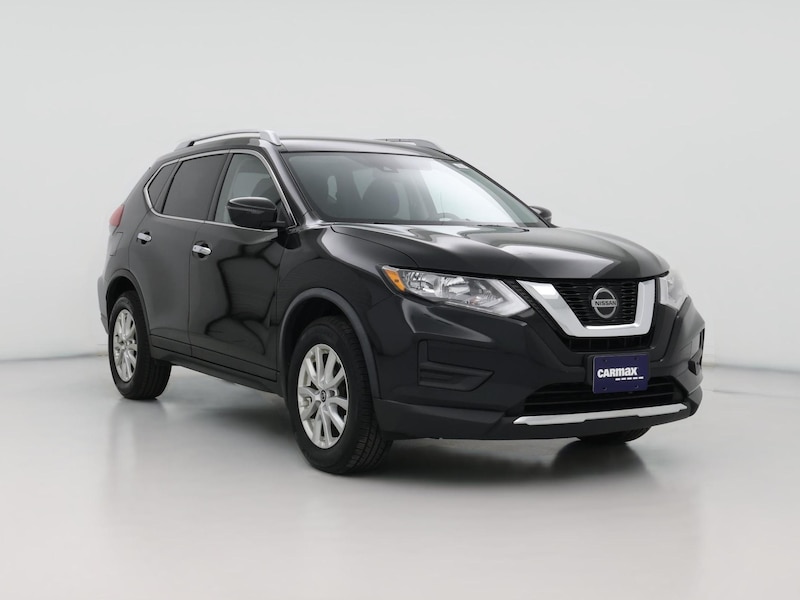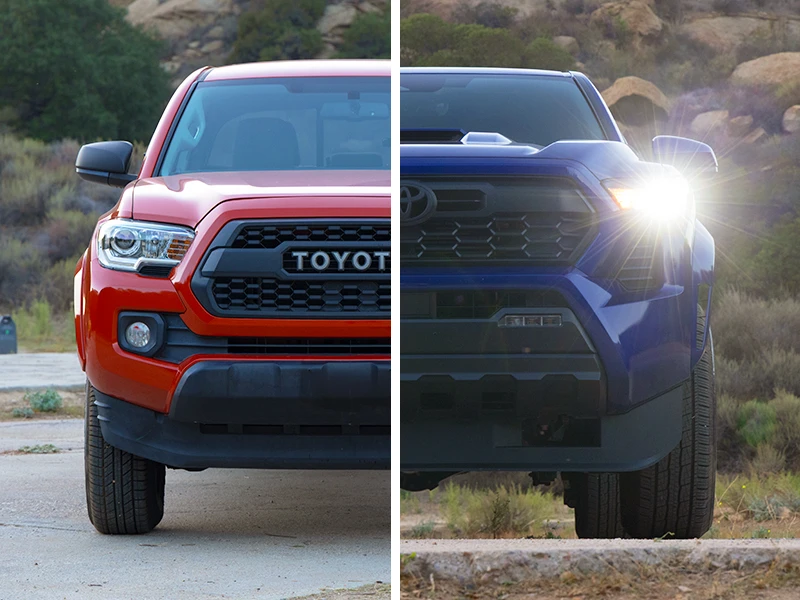A pair of practical, comfortable SUVs.

When it comes to day-to-day practicality, crossover SUVs have space, power, and comfort for everyone. Two popular options in this class are the Hyundai Santa Fe and Nissan Rogue. Both vehicles offer everything you're looking for in an SUV, including five-passenger seating, driver-assist tech, modern streaming features, and flexible cargo space.
If you're still looking for the right SUV, take a look at the other comparisons in this series:
If you're considering one of these crossover SUVs, we've created this side-by-side comparison to help you pick the right one. Read on to compare the Hyundai Santa Fe vs. the Nissan Rogue.
Side-by-Side Comparison

2019 Hyundai Santa Fe | 2019 Nissan Rogue | |
|---|---|---|
Average Price | $24,000 | $20,500 |
Performance | ||
Base Engine | 2.4L four-cylinder | 2.5L four-cylinder |
Horsepower | 185 hp | 170 hp |
MPG | 25 mpg combined | 29 mpg combined |
Interior | ||
Seating | 5 | 5 |
Cargo Space | 35.9 cu-ft | 39.3 cu-ft |
Front-seat Legroom | 44.1 inches | 43 inches |
Rear-seat Legroom | 40.9 inches | 37.9 inches |
Overall Interior Space | 146.6 cu-ft | 134 cu-ft |
Ratings | ||
Tailpipe Emissions | 362 g/mile | 312 g/mile |
NHTSA Safety Rating | 5/5 | 5/5 |
Certain vehicles may have unrepaired safety recalls. Click here to look up a specific vehicle.
Features and Trim Options
While the Hyundai Santa Fe and Nissan Rogue are two different approaches to an SUV, they offer a range of trims and features that will check the boxes on your must-have list.
Hyundai Santa Fe
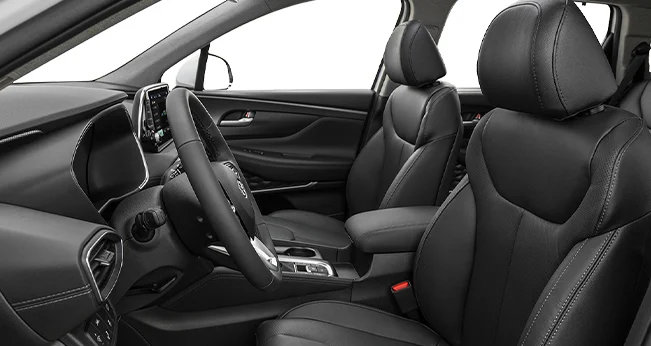
Packed full of style and technology, the Hyundai Santa Fe is a modern family SUV that's suitable for all groups. Even the base model is well-equipped, including some of these standard features on all 2019–2020 models:
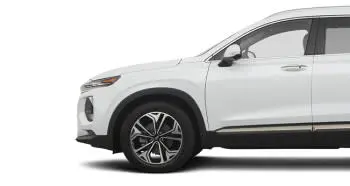
A seven-inch touchscreen with Android Auto® and Apple CarPlay™ connectivity
Forward-collision avoidance with pedestrian protection
Lane-keep assist
Blindspot and rear cross-traffic monitoring.
Nissan Rogue

Form meets function in the Nissan Rogue. Available AWD provides the kind of confident traction you need in bad weather and impressive cargo space (39.3 cu-ft behind the second row) makes hauling large items a breeze. If you regularly carry armfuls of items to the trunk, look for the easy-access kick-activated tailgate, which is an available option from 2017. All 2017–2020 Nissan Rogue models include:

A five-inch touchscreen with Bluetooth® audio streaming
Reclining and split-folding second-row seats
A rearview camera
Engine Options
Both the Hyundai Santa Fe and Nissan Rogue offer a selection of capable four-cylinder engines—you'll also find an optional hybrid powertrain on the 2017–2020 Rogue.
On the 2019–2020 Hyundai Santa Fe you’ll get:

A standard 185 hp 2.4L four-cylinder engine
An available 235 hp turbocharged 2.0L four-cylinder engine
The 2017–2020 Nissan Rogue is powered by:
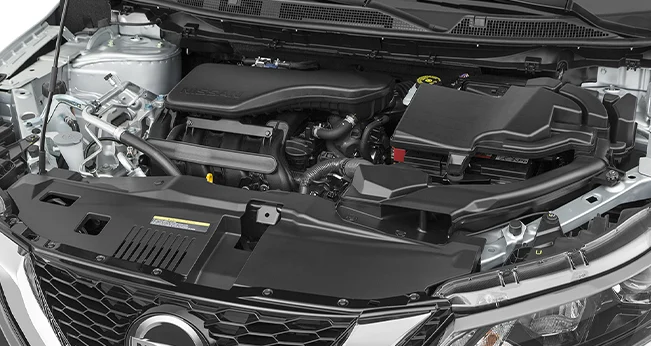
A standard 170 hp 2.5L four-cylinder engine
An optional hybrid powertrain with 176 combined hp, featuring a 2.0L four-cylinder engine
Fuel Economy
If you're looking to maximize the distance between visits to the pump, or if you do a lot of around-town driving, take a look at the mpg stats for these SUVs.
The FWD 2019 Hyundai Santa Fe with the 2.4L four-cylinder engine gets an EPA-estimated 22 mpg city and 29 mpg highway.† If you opt for the more powerful turbocharged 2.0L four-cylinder, you can expect an FWD 2019 Hyundai Santa Fe to get an EPA-estimated 22 combined mpg.†
The FWD 2019 Nissan Rogue gets an impressive EPA-estimated 33 mpg city and 35 mpg highway for a combined 34 mpg.1 An AWD 2019 Nissan Rogue Hybrid still reaches an impressive EPA-estimated 33 mpg combined.† You can still go for an extended cruise in the base 2019 FWD Nissan Rogue and 2.5L four-cylinder, which boasts an EPA-estimated 26 mpg city and 33 mpg highway.†
Towing
If towing a small trailer or RV is an important feature, then a 2019–2020 Hyundai Santa Fe powered by the turbocharged 2.0L four-cylinder engine can tow up to an estimated 3,500 pounds, when properly equipped.†† All other 2019–2020 Hyundai Santa Fe models can to up to an estimated 2,000 pounds, when properly equipped.†† The 2017–2020 Nissan Rogue has a smaller towing capacity, with all models able to pull up to an estimated 1,100 pounds, when properly equipped.††
Tech Features
Modern technology is an essential part of any SUV. You'll find a selection of the most popular tech features in the Hyundai Santa Fe and Nissan Rogue. Both the 2019–2020 Nissan Rogue and Hyundai Santa Fe offer Android Auto and Apple CarPlay connectivity as standard. The 2017–2018 Nissan Rogue does include Bluetooth streaming technology but is missing Android Auto and Apple CarPlay integration. A suite of driver aids is included in the 2017–2018 Nissan Rogue SV and higher trims but is standard on 2019–2020 Nissan Rogue and 2019–2020 Hyundai Santa Fe.
Hyundai Santa Fe
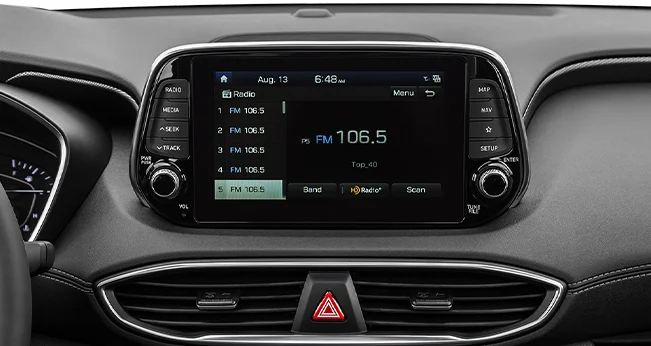
Android Auto and Apple CarPlay connectivity (2017–2020)
Adaptive cruise control, lane-keep assist, blind-spot monitoring, rear cross-traffic alert (2017–2020)
A seven-inch touchscreen (2017–2020)
Wireless charging (Ultimate trim from 2017–2020)
An eight-inch high-resolution touchscreen with live traffic navigation (Ultimate trim from 2017–202)
Nissan Rogue

Adaptive cruise control, blind-spot monitoring, rear cross-traffic alerts (standard 2019–2020, SV and higher 2017–2018)
A five-inch touchscreen (2017–2018 models) or seven-inch touchscreen (2019–2020 models)
Apple CarPlay and Android Auto connectivity (2019–2020 models)
Navigation with live traffic (SL and higher from 2017–2020)
Cargo Space
Flexible cargo space is one of the benefits of owning an SUV. You'll find form meets functionality in both the Hyundai Santa Fe and Nissan Rogue.
Hyundai Santa Fe
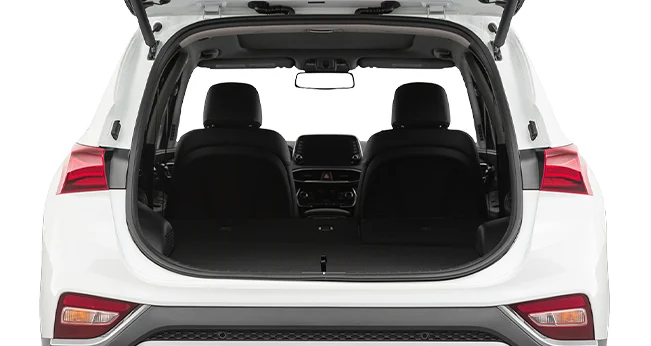
Get 35.9 cu-ft of cargo space behind the 2019–2020 Hyundai Santa Fe, or open it up for an impressive 71.3 cu-ft behind the first row.
Nissan Rogue

A 2017–2020 Nissan Rogue can fit up to 39.3 cu-ft of luggage behind the second-row seats. Rear cargo space opens up to 70 cu-ft with the second-row folded flat.
Pricing
See below for average CarMax prices for various model years of the Hyundai Santa Fe and Nissan Rogue.†††
Hyundai Santa Fe
2017 — Average prices less than $23,0003†††
2018 — Average prices less than $24,5003†††
2019 — Average prices less than $24,0003†††
2020 — Average prices less than $24,0003†††
Nissan Rogue
2017 — Average prices less than $18,0003†††
2018 — Average prices less than $19,0003†††
2019 — Average prices less than $20,5003†††
2020 — Average prices less than $21,5003†††
Safety Ratings
The 2019 Hyundai Santa Fe achieved an overall 5/5 safety rating by the National Highway Traffic Safety Administration (NHTSA), while the 2019 Nissan rogue earned an overall 4/5 star safety rating. Certain vehicles may have unrepaired safety recalls. Click here to look up a specific vehicle.
Hyundai Santa Fe
RepairPal gave the Hyundai Santa Fe an overall reliability rating of 4 out of 5 stars, which RepairPal describes as above average.
Cost: RepairPal reports that the average total annual cost for repairs and maintenance on a Hyundai Santa Fe is $515, compared to an average of $573 for Midsized SUVs and $652 for all the vehicles RepairPal considered in its dataset.
Frequency: According to RepairPal, Hyundai Santa Fe owners bring their vehicles into a repair shop for unscheduled repairs an average of 0.2 times per year, compared to an average of 0.4 times for Midsized SUVs and 0.4 times for all the vehicle models RepairPal considered in its dataset.
Severity: RepairPal reported that the probability of a repair being a severe or major issue is 10% for the Hyundai Santa Fe, compared to an average of 13% for Midsized SUVs and 12% for all the vehicles RepairPal considered in its dataset.
2019 Hyundai Santa Fe
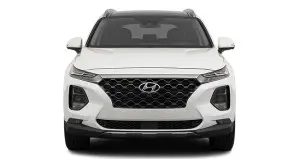
Frontal Barrier Crash Rating Test: A head-on collision between two similar vehicles traveling at 35 mph.
Overall: 4/5
Side Barrier Crash Rating Test: A vehicle standing in an intersection sustains driver-side impact from a vehicle moving at 38.5 mph.
Overall: 5/5
Side Pole Crash Rating Test: A vehicle slides sideways at 20 mph and impacts a tree or telephone pole.
Overall: 5/5
Nissan Rogue
RepairPal gave the Nissan Rogue an overall reliability rating of 4 out of 5 stars, which RepairPal describes as above average.
Cost: RepairPal reports that the average total annual cost for repairs and maintenance on a Nissan Rogue is $467, compared to an average of $521 for Compact SUVs and $652 for all the vehicles RepairPal considered in its dataset.
Frequency: According to RepairPal, Nissan Rogue owners bring their vehicles into a repair shop for unscheduled repairs an average of 0.3 times per year, compared to an average of 0.3 times for Compact SUVs and 0.4 times for all the vehicle models RepairPal considered in its dataset.
Severity: RepairPal reported that the probability of a repair being a severe or major issue is 12% for the Nissan Rogue, compared to an average of 11% for Compact SUVs and 12% for all the vehicles RepairPal considered in its dataset.
2019 Nissan Rogue

Frontal Barrier Crash Rating Test: A head-on collision between two similar vehicles traveling at 35 mph.
Overall: 4/5
Side Barrier Crash Rating Test: A vehicle standing in an intersection sustains driver-side impact from a vehicle moving at 38.5 mph.
Overall: 5/5
Side Pole Crash Rating Test: A vehicle slides sideways at 20 mph and impacts a tree or telephone pole.
Overall: 4/5
Reliability
The Hyundai Santa Fe and Nissan Rogue are rated with above-average reliability when compared with other similar SUVs. The average repair cost, frequency, and severity are lower than those for midsized or compact SUVs. Both the Hyundai Santa Fe and Nissan Rogue receive a RepairPal score of 4/5 for reliability.
Hyundai Santa Fe
RepairPal gave the Hyundai Santa Fe an overall reliability rating of 4 out of 5 stars, which RepairPal describes as above average.
Cost: RepairPal reports that the average total annual cost for repairs and maintenance on a Hyundai Santa Fe is $515, compared to an average of $573 for Midsized SUVs and $652 for all the vehicles RepairPal considered in its dataset.
Frequency: According to RepairPal, Hyundai Santa Fe owners bring their vehicles into a repair shop for unscheduled repairs an average of 0.2 times per year, compared to an average of 0.4 times for Midsized SUVs and 0.4 times for all the vehicle models RepairPal considered in its dataset.
Severity: RepairPal reported that the probability of a repair being a severe or major issue is 10% for the Hyundai Santa Fe, compared to an average of 13% for Midsized SUVs and 12% for all the vehicles RepairPal considered in its dataset.
Nissan Rogue
RepairPal gave the Nissan Rogue an overall reliability rating of 4 out of 5 stars, which RepairPal describes as above average.
Cost: RepairPal reports that the average total annual cost for repairs and maintenance on a Nissan Rogue is $467, compared to an average of $521 for Compact SUVs and $652 for all the vehicles RepairPal considered in its dataset.
Frequency: According to RepairPal, Nissan Rogue owners bring their vehicles into a repair shop for unscheduled repairs an average of 0.3 times per year, compared to an average of 0.3 times for Compact SUVs and 0.4 times for all the vehicle models RepairPal considered in its dataset.
Severity: RepairPal reported that the probability of a repair being a severe or major issue is 12% for the Nissan Rogue, compared to an average of 11% for Compact SUVs and 12% for all the vehicles RepairPal considered in its dataset.
RepairPal Reliability Ratings are based on the actual cost, frequency, and severity of unscheduled repairs and maintenance on make/model data for select 2010–2019 vehicles. The reliability of a specific vehicle may vary depending on its maintenance and driving history, model year, trim, and features.
*RepairPal Reliability Ratings are provided by RepairPal and CarMax is not responsible for their accuracy. These ratings are based on RepairPal Reliability data as of 12/31/2018. Learn more.
Performance
Hustling from zero to 60 in just 7.8 seconds, the 2019–2020 Hyundai Santa Fe posts the fastest time with the 235 hp turbocharged 2.0L four-cylinder engine (according to the manufacturer, when new).
With the turbocharged 2.0L four-cylinder, you can expect an EPA-estimated 22 mpg combined in a FWD 2019–2020 Hyundai Santa Fe.†
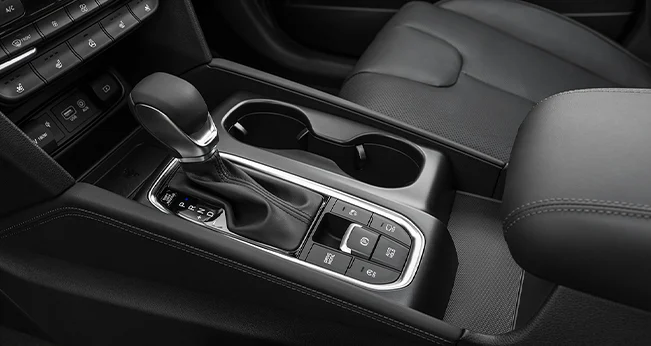
The 2017–2020 FWD Nissan Rogue gets up to 60 mph from zero in 8.2 seconds, thanks to a 170 hp 2.5L engine and CVT (according to the manufacturer, when new). A FWD 2017–2020 Nissan Rogue with the 2.5L four-cylinder gets an EPA-estimated 29 mpg combined.†
The quick-shifting eight-speed automatic in a 2019–2020 Hyundai Santa Fe makes for quick passes on the road. Or, get a smooth and comfortable ride in a 2017–2020 Nissan Rogue thanks to its CVT.

Emissions
Hyundai Santa Fe
According to EPA estimates, the 2019 Hyundai Santa Fe gets the following tailpipe greenhouse gas emissions:
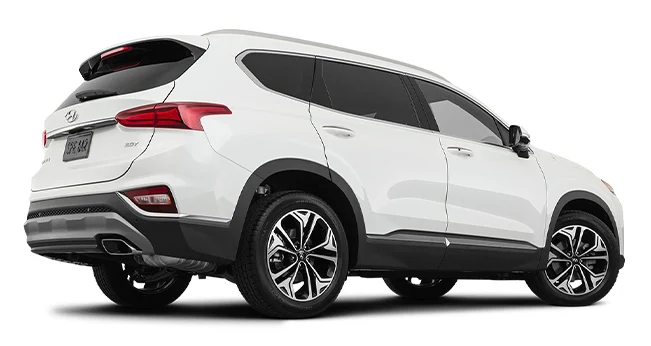
FWD 2.4L four-cylinder engine gets an estimated 362 grams per mile.
AWD 2.4L four-cylinder engine gets an estimated 380 grams per mile.
FWD turbocharged 2.0L four-cylinder gets an estimated 408 grams per mile.
AWD turbocharged 2.0L four-cylinder gets an estimated 422 grams per mile.
Nissan Rogue
According to EPA estimates, the 2019 Nissan Rogue gets the following tailpipe greenhouse gas emissions:

FWD 2.5L four-cylinder engine gets an estimated 312 grams per mile.
AWD 2.5L four-cylinder engine gets an estimated 324 grams per mile.
FWD 2.0L hybrid powertrain gets an estimated 261 grams per mile.
AWD 2.0L hybrid gets an estimated 276 grams per mile.
These estimates are based on a brand-new model. Visit fueleconomy.gov for more details.
The Bottom Line
When you're looking for the functionality and space for a group of people to travel comfortably, an SUV like the Hyundai Santa Fe or Nissan Rogue is a great choice. Both offer powerful engines, AWD for confident traction, and plenty of cargo space. A Nissan Rogue provides a smooth ride that's perfect for long journeys and your daily commute. At the same time, the Hyundai Santa Fe stays connected with mobile connectivity and the tech features you want.
Do you want to learn more? Check out some of these additional resources:




